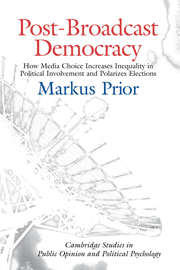 Post-Broadcast Democracy
Post-Broadcast Democracy Published online by Cambridge University Press: 05 July 2014
Choosing every night between a scant three or four channels, television viewers in the broadcast period inspired the term “captive” audience. When the networks scheduled news, people watched news. Starting in the 1970s, the captives' chains were loosened, albeit slowly. Early cable television only served to bring broadcast signals to rural or mountainous areas. The percentage of homes with cable television was less than 2 percent before 1965 and only 7.6 percent in 1970. Before it became more commercial in the seventies, cable television was just another transmission device, not yet a source of original programming. This began to change in the 1970s when cable channels such as Home Box Office (HBO), Ted Turner's WTBS, and Sports Programming Network (now ESPN) began operating. Slowly, more and more Americans became subscribers. Cable reached a third of all households by 1983 and more than half of them by 1989. In the mid-1990s, satellite technology offered another way to leave the broadcast days. Cable or satellite television was in 70 percent of all homes by 1997 and passed the 85 percent mark in 2004.
When alternatives increase, people have more choice, and their own motivations for watching become more important in predicting their viewing behavior. With the advent of cable, the supply of programming in many television genres expanded (e.g., Becker and Schoenbach 1989; Weimann 1996). Cable subscribers are offered more movies than captive audiences with only an antenna.
To save this book to your Kindle, first ensure [email protected] is added to your Approved Personal Document E-mail List under your Personal Document Settings on the Manage Your Content and Devices page of your Amazon account. Then enter the ‘name’ part of your Kindle email address below. Find out more about saving to your Kindle.
Note you can select to save to either the @free.kindle.com or @kindle.com variations. ‘@free.kindle.com’ emails are free but can only be saved to your device when it is connected to wi-fi. ‘@kindle.com’ emails can be delivered even when you are not connected to wi-fi, but note that service fees apply.
Find out more about the Kindle Personal Document Service.
To save content items to your account, please confirm that you agree to abide by our usage policies. If this is the first time you use this feature, you will be asked to authorise Cambridge Core to connect with your account. Find out more about saving content to Dropbox.
To save content items to your account, please confirm that you agree to abide by our usage policies. If this is the first time you use this feature, you will be asked to authorise Cambridge Core to connect with your account. Find out more about saving content to Google Drive.